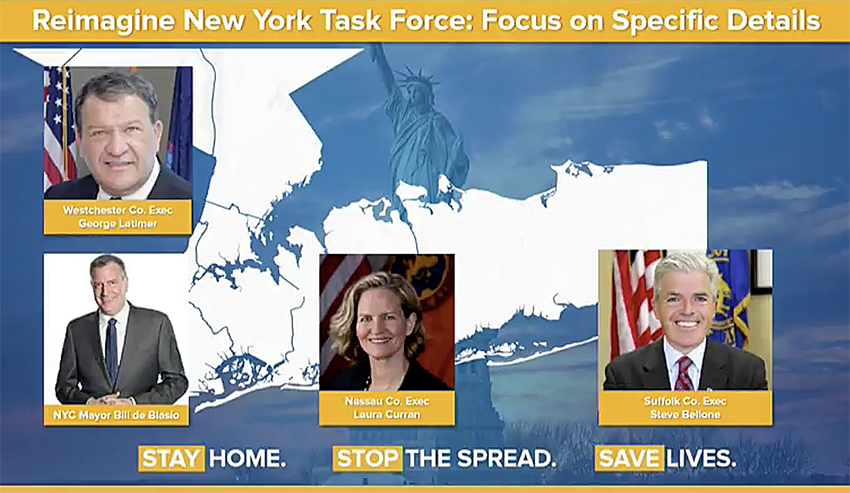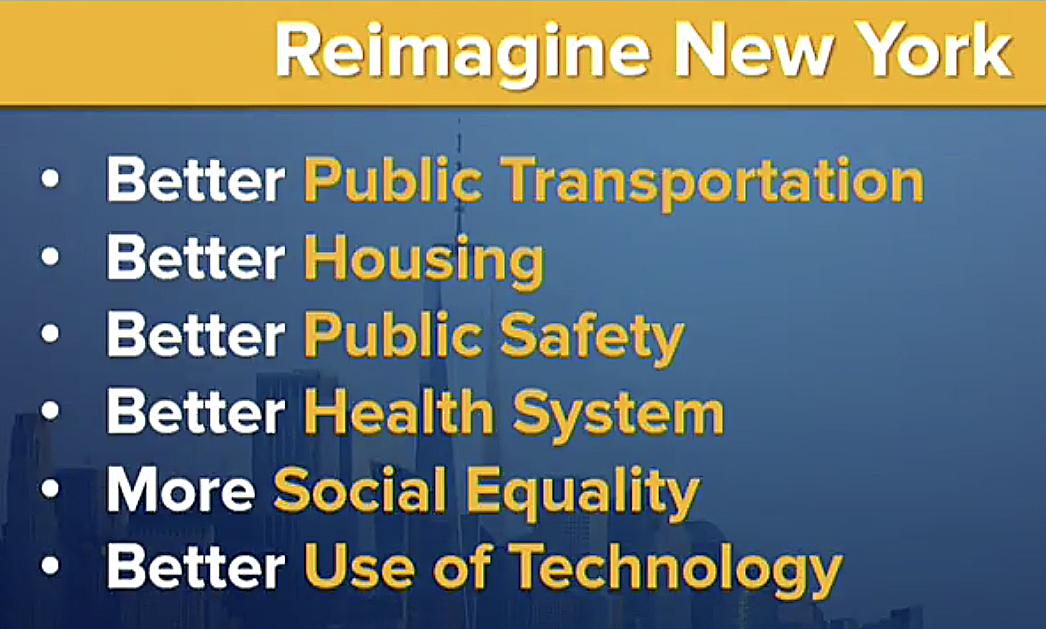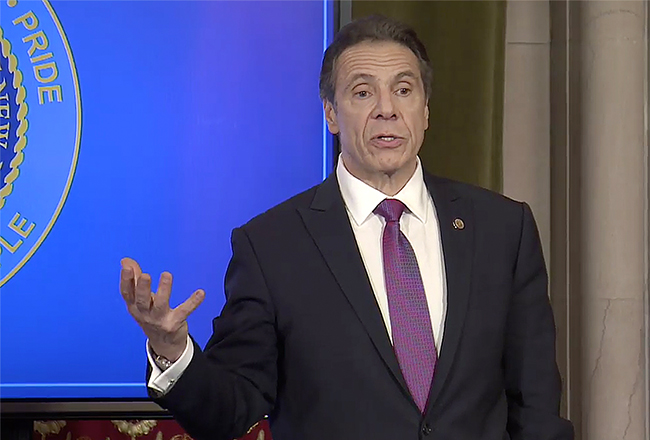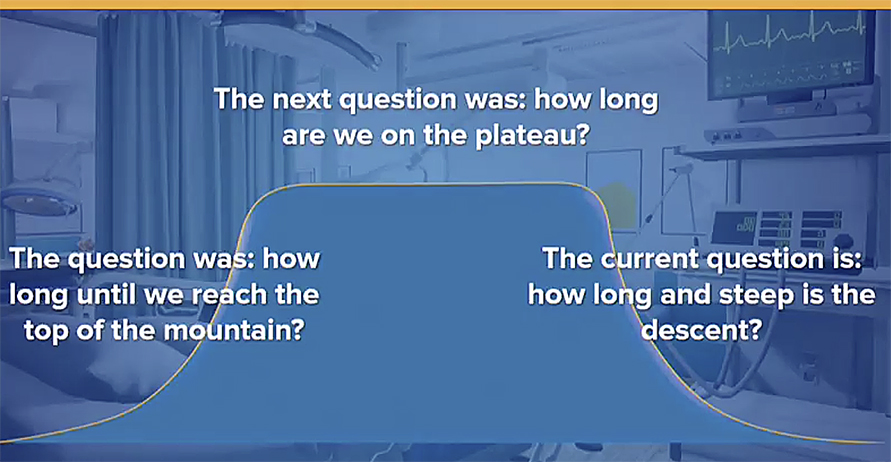Fast Facts:
-
The governor said that today he would be asking Washington to increase hazard pay for essential public workers, suggesting a 50% bonus
-
The governor pointed out that two-thirds of the frontline workers nationwide are women and one-third are members of a low-income household
-
The governor said 41% of frontline workers are people of color
-
In thanking frontline workers, the governor also said that people of color are also disproportionately represented in delivery services and child care services
-
The governor noted that today is 92 days since the first coronavirus case was detected in the U.S.
-
New York is beginning a partnership with Ready Responders to bring diagnostic testing to residents of public housing in New York City. In addition, the state will be delivering 500,000 cloth masks and 10,000 gallons of hand sanitizer to public housing communities
-
There were 478 deaths, down from the previous day”™s 507
-
Total hospitalizations continued to decline in New York state
-
Intubations also continued to drop

Westchester County Executive George Latimer will be one of four political leaders serving on a task force to develop plans that will “reimagine” a brighter future for New York state once it emerges from the COVID-19 crisis.
Gov. Andrew M. Cuomo announced formation of the task force at an Albany news conference on Monday. Also announced as members of the task force were New York City Mayor Bill De Blasio, Nassau County Executive Laura Curran and Suffolk County Executive Steve Bellone.
The task force, given the name Reimagine New York, will focus on devising ways to introduce better public transportation, better housing, better public safety, a better health system, more social equality and the better use of technology in education, in telemedicine and in business such as expanding the ability to work from home.
“We’re going to have a reimagine task force that focuses primarily on downstate New York, which has been the most affected area and led by the state with those local elected officials, but let’s get the best housing experts, let’s get the best transportation experts and let’s use this as a moment to plan change that we would normally never do unless you had this situation,” Cuomo said.
He said that in the meantime, as the state moves toward reopening the economy, it is important to do no harm and watch to see that the infection rate doesn’t start to increase again.
 Cuomo reported that yesterday there were another 478 deaths in New York state from COVID-19, bringing the total to 14,347. The number of deaths yesterday was about 36% below the 752 reported for last Tuesday and continued the week’s downward trend. The number of people in hospitals was put at 16,103, a slight drop from Saturday’s 16,713 and a continuation of the downward trend. More patients were being taken off of ventilators than were being put on, with 32 fewer patients requring breathing machines yesterday than the day before.
Cuomo reported that yesterday there were another 478 deaths in New York state from COVID-19, bringing the total to 14,347. The number of deaths yesterday was about 36% below the 752 reported for last Tuesday and continued the week’s downward trend. The number of people in hospitals was put at 16,103, a slight drop from Saturday’s 16,713 and a continuation of the downward trend. More patients were being taken off of ventilators than were being put on, with 32 fewer patients requring breathing machines yesterday than the day before.
Cuomo said that only the federal government can ensure that there will be an unbroken supply chain for the equipment and supplies that will be necessary for adequate testing as the various stages of reopening the economy unfold.
He said that operators of laboratories in the state have told him the number of tests they can perform is being restricted because they can’t get supplies. Some chemicals used in the tests are manufactured in China and other countries and, according to Cuomo, the states lack the international clout of the federal government to get them.
Cuomo was again sharply critical of the federal government for not adequately funding state governments while at the same time loading them up with responsibilities during the crisis. He noted that President Trump again said over the weekend that states and not the federal government should be in charge of the testing throughout the country that will be required to determine the extent to which the economy can be safely reopened.

“They want to fund financial services and large corporations and airlines and hotels. Yeah, that’s all great. Fund all those businesses, but at the same time don’t forget teachers and police officers and fire fighters and transit workers and health care workers and nursing home staff because those are the people who I fund in the state budget,” Cuomo said. “You shouldn’t make us choose between small businesses and large businesses and people who are on the front line doing the work day in and day out. I would go even a step further and I would propose hazard pay for frontline workers.”
Cuomo said that if the federal government continues to exclude state governments from funding in its economic recovery bills as it has in the past, he would be forced to cut funding to schools by 20%, funding to local governments by another 20% and funding to hospitals by 20% just for openers.
Cuomo suggested that one reason statistics seem to indicate that among the hardest hit with the virus are African-Americans and Hispanics is that they form a significant sector of the workers who have remained on the job during the crisis.
Cuomo presented a demographic breakdown showing that 41% of the frontline workers are people of color. That included 45% of public transit workers, 57% of building cleaning service workers and 40% of health care workers.
 “The economy did not close down,” Cuomo said. “It closed down frankly for those people that had the luxury of staying at home. All those essential workers who had to get up every morning to put food on the shelves and go to the hospitals to provide health care under extraordinary circumstances and the police officers who had to go out to keep you safe and the fire fighters who still had to go out and fight the fire, those people worked and they went out there and exposed themselves to the virus.” Cuomo proposed that the federal government should provide a 50% hazard pay bonus to frontline workers.
“The economy did not close down,” Cuomo said. “It closed down frankly for those people that had the luxury of staying at home. All those essential workers who had to get up every morning to put food on the shelves and go to the hospitals to provide health care under extraordinary circumstances and the police officers who had to go out to keep you safe and the fire fighters who still had to go out and fight the fire, those people worked and they went out there and exposed themselves to the virus.” Cuomo proposed that the federal government should provide a 50% hazard pay bonus to frontline workers.
Cuomo said the state will be working with the New York City Housing Authority to set up a pilot program to provide provide on-site health care services to residents of Housing Authority buildings.
Cuomo said that while New York may have passed the plateau of the outbreak, no one can tell just how long the downhill side of the epedemic’s mountain will be or how quickly the state will move down the slope.






















Naming Latimer to this is a disaster for all businesses.